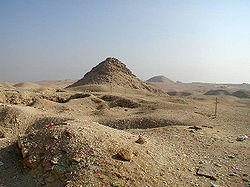| Millennium: | 3rd millennium BC |
|---|---|
| Centuries: | |
| Timelines: | |
| State leaders: |
|
| Decades: |
|
| Categories: |
Events
- c. 2900 BC – 2334 BC: Mesopotamian wars of the Early Dynastic period.
- c. 2686 BC: End of Second Dynasty, start of Third Dynasty in Egypt. Construction of Egyptian Pyramids begins.
- c. 2560 BC: Construction of the Great Pyramid of Giza is completed.
- c. 2500 BC: Rice was first introduced to Malaysia
- c. 2500 BC: Scribal schools flourish throughout Sumer.
- c. 2500 BC: Assyria is established.
- c. 2500 BC: Cylinder seal from Sumer and its impression are made. It is now in the Metropolitan Museum of Art, New York.
- c. 2500 BC: Excavation and development of the Hypogeum of Ħal-Saflieni at Paola, Malta, a subterranean temple complex subsequently used as a necropolis.
- c. 2500 BC: The Pyramid of Khafre, Giza, is built.
- c. 2500 BC: The sculpture Khafre Enthroned is made.
- c. 2500 BC: People in Peru rely on fish and mussels for food.
- c. 2500 BC: Evidence of long-distance trade routes in South America.[1]
- c. 2500 BC: Skara Brae is abandoned after approximately 600 years of occupation.
- c. 2500 BC – 2000 BC: Mohenjo-daro is about 7 square miles (18 km2) in size and has a population of c. 20,000 to 50,000.
- c. 2494 BC – 2345 BC: "Sculptors at work", relief from Saqqara, Fifth Dynasty. It is now at Egyptian Museum, Cairo, Egypt.
- c. 2494 BC – 2345 BC: The Seated Scribe, a sculpture found at Saqqara, Fifth Dynasty of Egypt is made. It is now in Musée du Louvre, Paris.
- 2492 BC: Traditional date for the legendary foundation of Armenia by Hayk.
- c. 2450 BC: End of the Early Dynastic IIIa Period and beginning of the Early Dynastic IIIb Period in Sumer.
- c. 2450 BC: Kish is lost to Hamazi tribesmen of the Kurdistan mountains; Elam under the Awan dynasty occupies parts of Sumer. (Roux 1980)
- c. 2410 BC: By this time, kings in Sumer have ceased to be automatically high priests of the city deity. (Roux 1980) Infiltration and conquest of Mesopotamia by ancient Semitic-speaking peoples begins. (1968 RD Almanac)
- c. 2400 BC–2200 BC: Construction of Stonehenge
- Megalithic culture begins to spread through Europe and the western Mediterranean. (1968 RD Almanac)
- Earliest signs of Corded Ware culture from the Caucasus. (Encyc. Americana)
- Southeastern Spain is settled from the Mediterranean, by people using Prehistoric Egyptian-style pottery. (Encyc. Americana)
- Amorites and Canaanites occupy Syria and Lebanon. (Encyc. Americana)
Significant persons
- 2492 BC—Hayk founds Armenia
- 2491 BC—Mythical Chinese Emperor Zhuanxu/ Mythical only as per Western historians.
- 2490 BC—Menkaure is Pharaoh. (Atlas of Egypt 1989)
- 2475 BC—Shepseskaf is Pharaoh. (Atlas of Egypt 1989)
- 2465 BC—Fifth Dynasty of Egypt; Userkaf is Pharaoh (Atlas of Egypt 1989)
- 2458 BC—Sahure is Pharaoh (Atlas of Egypt 1989)
- 2450 BC—Tudiya becomes the earliest king of Assyria[2]
- 2446 BC—Neferirkare Kakai is Pharaoh (Atlas of Egypt 1989)
- 2426 BC—Shepseskare is Pharaoh (Atlas of Egypt 1989)
- c. 2425 BC—Death of Eannatum of Lagash; succeeded by his nephew, Entemena, whose ally, Lugal-kinishe-dudu, unites Uruk and Ur (Roux 1980)
- 2419 BC—Neferefre is Pharaoh (Atlas of Egypt 1989)
- 2416 BC—Nyuserre Ini is Pharaoh (Atlas of Egypt 1989)
Inventions, discoveries, introductions
- Indus Valley Civilisation, at its peak, covered an area of around 480,000 km² (185,329 mi²), an area just over half the size of present-day Pakistan. Its heartland lay in the Indus River in Pakistan, but settlements spread as far as the Makran coast, Balochistan, Afghanistan, eastern Punjab, Kutch and Saurashtra. They included cities like Harappa, Mohenjo-daro, Kalibangan, Dholavira, ports like Lothal, Sutkagen-dor and Sokhta Koh and numerous villages as well. They used irrigation to farm and constructed cities. The two main cities had sewage systems, bronze, trade tokens (early coins), and hieroglyphs. There were even baths at one of the villages, besides the great baths of brick in each city. Geometry of shrines and altars tends to identify these with the cities of the Yajurveda.
- Sahure is the earliest known king to make use of a high-seas navy to transport troops over the sea.
- Cycladic marble figures depict the use of both the musical pipe and the cithara. (Archaeology of the Olympics 1988)
- Earliest surviving ski is left in a bog at Hoting, Sweden, about this time. (Encyc. Americana)
- Sumerians use domestic donkeys on war chariots (Standard of Ur), not onagers as early interpreters claimed. (Clutton-Brock)
- Agriculture at Huaca Prieta includes cotton and calabashes. (Bailey 1973)
- Statue of Ebih-Il, at Mari
References
- ^ Timelines of History: The Ultimate Visual Guide to the Events That Shaped the World. Dorling Kindersley. 2011. p. 26. ISBN 978-0-7566-8945-2.
- ^ Meissner, Bruno (1990). Reallexikon der Assyriologie. 6. Berlin: Walter de Gruyter. p. 103. ISBN 3110100517.
